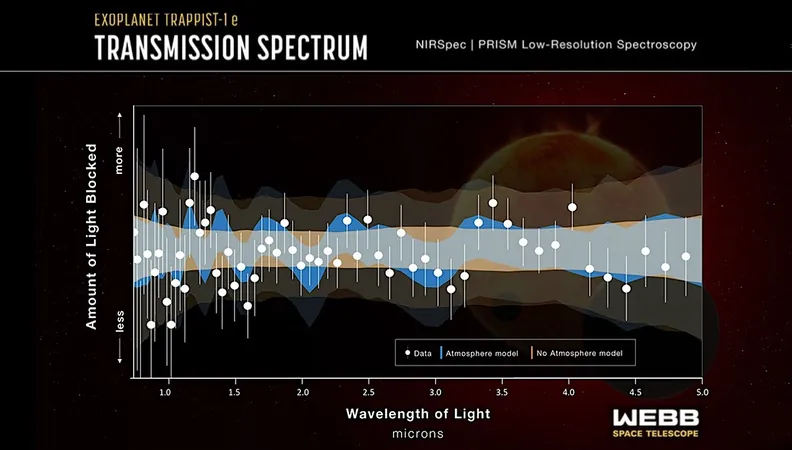
Unlocking the Secrets of TRAPPIST-1 e: Could This Exoplanet Harbor Life?
2025-09-15
Author: Nur
Exploring TRAPPIST-1 e: The Search for Life Beyond Earth
Astronomers are diving deep into the mysteries of exoplanet TRAPPIST-1 e using the advanced capabilities of NASA's James Webb Space Telescope (JWST). This groundbreaking research is paving the way to answer one of humanity's most profound questions: "Are we alone in the universe?"
According to Néstor Espinoza from the Space Telescope Science Institute, the infrared tools of the JWST are providing insights never before accessible. "The initial data from our observations of planet e is laying a solid foundation for the exciting research that lies ahead," he stated, referring to new findings published in the renowned Astrophysical Journal Letters.
TRAPPIST-1: A Unique Star System
Among seven Earth-sized planets orbiting the red dwarf star TRAPPIST-1, planet e stands out for its favorable position. It orbits at a sweet spot where water could exist on its surface—a crucial ingredient for life—provided it possesses an atmosphere.
By capturing starlight as TRAPPIST-1 e transits its star, scientists can identify chemicals in its atmosphere, if present, based on how much light is absorbed. With each additional transit observed, researchers gain clearer insights into the potential atmospheric composition.
Atmospheric Mysteries: What Lies Beneath?
So far, early indications suggest that TRAPPIST-1 e has likely lost its original atmosphere due to the star's intense radiation. Espinoza's team posits that while many planets develop a secondary atmosphere after losing their primary one, this may not be true for TRAPPIST-1 e. Yet, there’s also the possibility that a stable atmosphere could exist.
Importantly, the researchers believe the atmosphere isn't likely dominated by carbon dioxide like Venus, but that there are still essential questions to explore. "TRAPPIST-1 presents a vastly different environment compared to our solar system, making every observation a new challenge," remarked Nikole Lewis, an associate professor at Cornell University.
Liquid Water: A Sign of Life?
If liquid water does exist on TRAPPIST-1 e, it would likely be confined to regions with a greenhouse effect, keeping the planet warm. The researchers are excited about the possibilities: water could form a global ocean or exist in patches along sunlit areas, while the rest of the planet remains icy due to tidal locking.
Innovative Techniques: Observing in Tandem
Espinoza and his team are shaking things up with a novel approach: they are timing observations so that TRAPPIST-1 b and e transits occur back-to-back. This strategy allows for clearer data, isolating signals from planet e’s atmosphere more effectively, as scientists can compare the spectra of both planets.
As Ana Glidden, a post-doctoral researcher at MIT, put it, "We are entering a thrilling era of exploration, learning more about Earth-sized worlds 40 light-years away and their potential to harbor life. The discoveries we’re making with Webb are nothing short of extraordinary."
A New Dawn in Astrobiology
The findings about TRAPPIST-1 e are part of the larger DREAMS collaboration focused on exoplanet atmospheres using multi-instrument spectroscopy. The James Webb Space Telescope is at the forefront of this pursuit, illuminating the mysteries of our solar system and those beyond.
As this mission unfolds, the search for life elsewhere continues to deepen, hinting at the vast possibilities of what may exist beyond our own planet.





 Brasil (PT)
Brasil (PT)
 Canada (EN)
Canada (EN)
 Chile (ES)
Chile (ES)
 Česko (CS)
Česko (CS)
 대한민국 (KO)
대한민국 (KO)
 España (ES)
España (ES)
 France (FR)
France (FR)
 Hong Kong (EN)
Hong Kong (EN)
 Italia (IT)
Italia (IT)
 日本 (JA)
日本 (JA)
 Magyarország (HU)
Magyarország (HU)
 Norge (NO)
Norge (NO)
 Polska (PL)
Polska (PL)
 Schweiz (DE)
Schweiz (DE)
 Singapore (EN)
Singapore (EN)
 Sverige (SV)
Sverige (SV)
 Suomi (FI)
Suomi (FI)
 Türkiye (TR)
Türkiye (TR)
 الإمارات العربية المتحدة (AR)
الإمارات العربية المتحدة (AR)